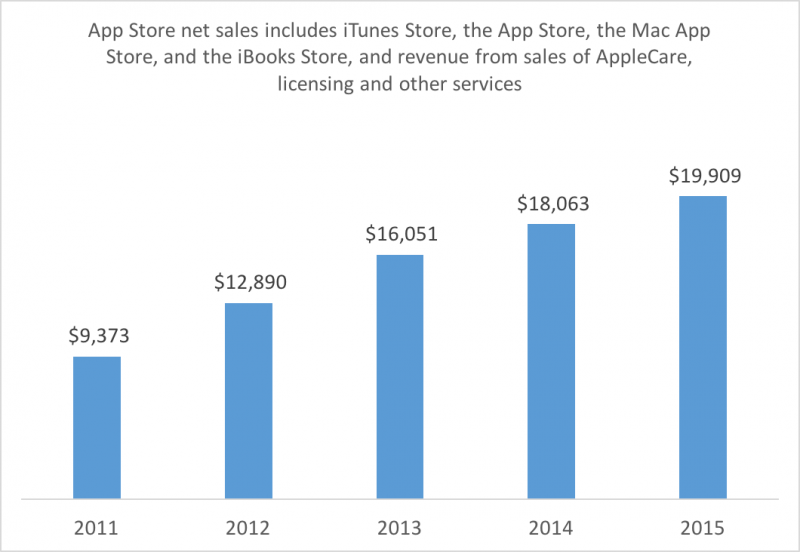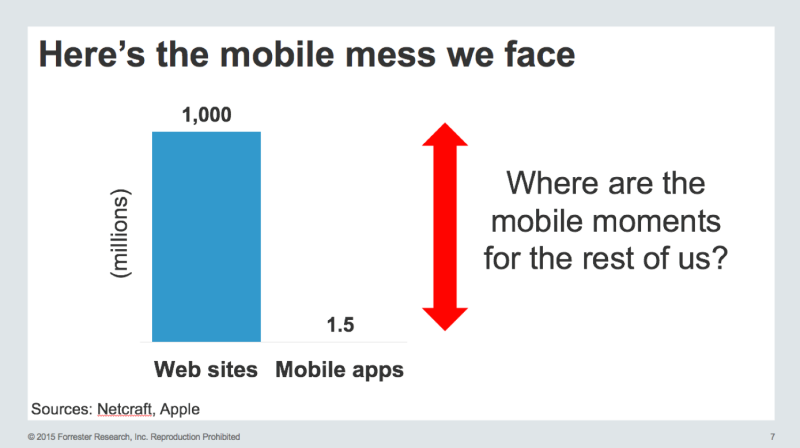Apple’s Real Innovation And Responsibility Is The App Store
Apple announced today that it sold $144 million in its App Store on January 1st and more than $20 billion in 2015. Wow. This from a company that launched $0.99 songs in 2001 on iTunes and didn't even consider apps to be useful when it introduced the iPhone in 2007. From public filings, Apple App Store net revenues (the 30% that Apple makes on digital media and app sales plus some other bits and pieces) grew from nothing in 2000 to $19,909 in fiscal year 2015 (see Figure 1). As you can see, growth is slowing down (though from a large base).
Figure 1 Apple's Reported App Store Net Sales. Source: Apple 10-K Filings

This App Store revenue breaks down into:
- Media, including music, video, and books. Apple launched iTunes (the original App Store) in 2001 with the blessing of the music industry. For the first time, publishers had a paid outlet for digital music. It's only grown from there.
- Apps. I remember vividly when my neighbor John told me he was coding apps on his nights and weekends (it was a brunch with snow outside in early 2009). That phenomenon — developers flocking to this new computer opened my eyes to the power of smartphones. Apps and in-store purchases are more than half of App Store revenues.
- In-app purchases. Apple keeps 30 cents for every dollar spent in an app, too. (It's why Amazon won't let you buy books in the Kindle app — it doesn't want to give Apple that 30 cents.)
- Other. Apple bundles in AppleCare and licensing so it's hard to see exactly what's what. If you look at the growth, however, you can bet that most growth comes from media, apps, and in-app purchases.
So what does $20 billion mean to Apple?
When media and apps were a $100 million business, Apple didn't care much about apps versus web. Now that it's a $20 billion business, it cares a lot about apps.
- Apple's world view has shifted from web to app, marginalizing its browser. With its focus on apps, Apple is less likely to follow Google's lead and make its Safari browser work more like an app, with access to the hardware. The New York Times nailed this battle royale between Apple and Google, between app and web, between open and closed. Flipkart, for example, is able to provide an app-like experience on Android running Chrome or on Firefox of Opera, but not on Safari.
- Publishers are more stuck than ever with Apple's digital distribution channel. Enough said here. Only Taylor Swift seems powerful enough to change Apple's mind about pricing.
- Apple provides tremendous benefit for developers building over-the-top (OTT) applications like Facebook, Snapchat, Skype, Uber, and Google Maps. This is the most beautiful outcome of the iPhone: hundreds of millions of stable devices forming a gigantic market for application developers. The forces of innovation Apple unleashed through the App Store will change the world more than the PC did. It's why we wrote The Mobile Mind Shift. Serving people in their mobile moments is reshaping every customer and business interaction.
- But Apple also wields tremendous control over those same applications. While I trust Apple to protect me (indeed, I rely in it), I also must trust Apple to keep the incentives high for developer innovation and access. This leads to the next section: what Apple should do.
What Apple Should Do To Keep App Store Innovation Going
But Apple also cares about growth, and that's slowing. To keep the font of innovation going (and staved off regulatory oversight), it's time for Apple to make the App Store a more open market and:
- Negotiate rates with publishers based on volume. There is precedent here as Apple now allows more expensive songs. It did that in response to the legitimate concerns of publishers.
- Create a pricing structure for in-app purchases that acknowledges Apple's limited role in that market. Paying 30 points on an app or title sale is one thing. But 30% for buying badges or time in Clash of Clans or Candy Crush or for a book on Kindle is ludicrous. App developers and publishers we speak with sigh and roll their eyes, but say they are powerless here. Apple could solve this by capping rates on in-app purchases based on volume.
- Make it much much easier for consumers to download one-time apps. Forrester's data says that consumers are stalled using only 26 apps on average for two years now. To break this app saturation, Apple must make it super easy for someone to click and get an app downloaded and installed so it becomes as convenient as the web. Click the QR code or enable auto-downloading to get the retail app, watch it disappear when you leave the store. Why not? That's how the web works.
- Embrace the mobile web as strongly as mobile apps. Apple once touted the browser as the best way use the iPhone. It should do so again. Why? Because there are a billion web sites (few of which are winning in the mobile moment while we're stalled at 1.5 million mobile apps (see Figure 2). Yes, the mobile web could cannibalize some app store purchases but it also sends the message that Apple loves the democratizing power of the open web. And it will increase the value and importance of iPhones because mobile web experiences will just get better if Apple joins with Google and Microsoft and other browser makers to provide PC-like power via standards to mobile browsers, encouraging those one billion websites to become much more app-like.
Figure 2 Where Are The Mobile Moments For The Rest Of Us?

